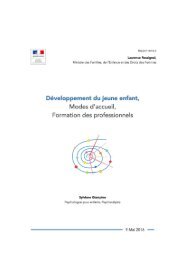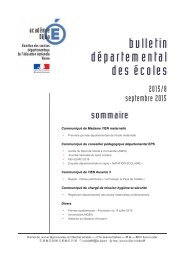agrl_innovations_in_ssa.pdf?utm_content=buffercb41d&utm_medium=social&utm_source=twitter
agrl_innovations_in_ssa.pdf?utm_content=buffercb41d&utm_medium=social&utm_source=twitter
agrl_innovations_in_ssa.pdf?utm_content=buffercb41d&utm_medium=social&utm_source=twitter
Create successful ePaper yourself
Turn your PDF publications into a flip-book with our unique Google optimized e-Paper software.
Innovation triggers. ICRISAT and NASFAM (see Box 4) supported by USAID, Government<br />
extension services and Tw<strong>in</strong> Trad<strong>in</strong>g have worked closely together as partners s<strong>in</strong>ce 2003 <strong>in</strong><br />
assist<strong>in</strong>g farmers to access high-value FairTrade export markets <strong>in</strong> the EU. It was realised that<br />
reduc<strong>in</strong>g aflatox<strong>in</strong> levels dur<strong>in</strong>g production and be<strong>in</strong>g able to identify aflatox<strong>in</strong> contam<strong>in</strong>ation<br />
of a groundnut consignment at source reduces not only the risk of shipment rejection but also<br />
results <strong>in</strong> ma<strong>in</strong>tenance of market share on the <strong>in</strong>ternational market.<br />
Stakeholder <strong>in</strong>teractions and <strong>in</strong>terventions. The stakeholder partnership comb<strong>in</strong>ed forces<br />
to <strong>in</strong>crease the productivity of groundnuts by provid<strong>in</strong>g improved varieties and improv<strong>in</strong>g<br />
smallholder management practices to <strong>in</strong>crease yields and reduce aflatox<strong>in</strong> contam<strong>in</strong>ation.<br />
This required the development of a system of grades and standards enabl<strong>in</strong>g participation<br />
<strong>in</strong> regional and <strong>in</strong>ternational markets and assistance <strong>in</strong> standards certification as well as the<br />
development of a traceability system so that the areas <strong>in</strong> which aflatox<strong>in</strong>s were a problem could<br />
be easily identified. Only then could a high-value market <strong>in</strong> Europe for smallholder-produced<br />
groundnuts be accessed. Improv<strong>in</strong>g productivity and develop<strong>in</strong>g standards certification<br />
<strong>in</strong>volved the establishment of on-farm demonstrations to tra<strong>in</strong> farmers <strong>in</strong> improved agronomic<br />
practices. Production standards were developed to ensure that farmers follow improved<br />
management practices to reduce the <strong>in</strong>cidence of the aflatox<strong>in</strong>-caus<strong>in</strong>g fungus. This <strong>in</strong>volved<br />
ICRISAT tra<strong>in</strong><strong>in</strong>g NASFAM and Government extension staff to understand the critical po<strong>in</strong>ts<br />
<strong>in</strong> the management of aflatox<strong>in</strong> dur<strong>in</strong>g production, harvest and postharvest handl<strong>in</strong>g (Siambi<br />
et al., 2008). Although farmers often prefer the variety Chalambana, because of its light sk<strong>in</strong><br />
colour, low oil content and large kernel size, which makes shell<strong>in</strong>g easier, it is susceptible to the<br />
fungus that causes aflatox<strong>in</strong> contam<strong>in</strong>ation. Improved varieties are higher yield<strong>in</strong>g and have<br />
some resistance to contam<strong>in</strong>ation. NASAFM and ICRISAT have worked closely to ensure certified<br />
seed of new varieties CG7, Chalambana 2000 and JL24 is accessible by farmers. Unfortunately<br />
weather conditions can exacerbate the aflatox<strong>in</strong> problem and postharvest handl<strong>in</strong>g can be<br />
critical <strong>in</strong> manag<strong>in</strong>g aflatox<strong>in</strong> levels. ICRISAT was <strong>in</strong>strumental <strong>in</strong> develop<strong>in</strong>g pyramid structures<br />
on which harvested groundnuts are placed, leaves upwards, so that pods dry and ra<strong>in</strong>water<br />
runs off without damag<strong>in</strong>g the pods. These pyramids are now widely used by farmers.<br />
Food safety requirements of the EU have a m<strong>in</strong>imum acceptance level (MAL) of aflatox<strong>in</strong><br />
contam<strong>in</strong>ation of 4 parts per billion (ppb) that requires a systematic approach to identify<br />
and elim<strong>in</strong>ate the sources of contam<strong>in</strong>ation. This required the establishment of laboratory<br />
facilities to establish a system for quality control for groundnuts purchased by NASFAM. Dur<strong>in</strong>g<br />
the early stages 200-g samples were taken from every 50-kg bag of groundnuts purchased.<br />
These were labelled to identify the grower and the centre from where it was purchased.<br />
The cod<strong>in</strong>g, record<strong>in</strong>g and gr<strong>in</strong>d<strong>in</strong>g of samples was undertaken by ICRISAT-Malawi and then<br />
sent to ICRISAT-India, for aflatox<strong>in</strong> contam<strong>in</strong>ation measurement. Test results were used for<br />
product differentiation and target<strong>in</strong>g different markets that permitted different MALs. When<br />
the traceability system was proved, analysis as undertaken <strong>in</strong>itially by ICRISAT- Malawi, until<br />
NASFAM was able to establish its own laboratory with staff tra<strong>in</strong>ed to measure aflatox<strong>in</strong>.<br />
NASFAM Associations are grouped by Market Access Centres, which provide support to<br />
members. Clubs sell their produce at designated Market Centres. This allows for traceability<br />
as samples are collected from groundnuts purchased by NASFAM and analysed for aflatox<strong>in</strong><br />
50 Agricultural Innovation <strong>in</strong> Sub-Saharan Africa






